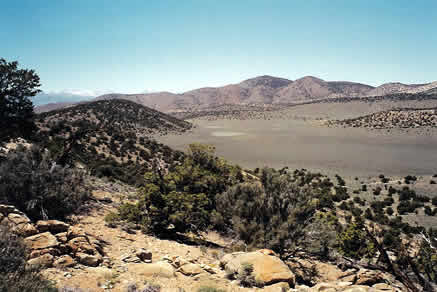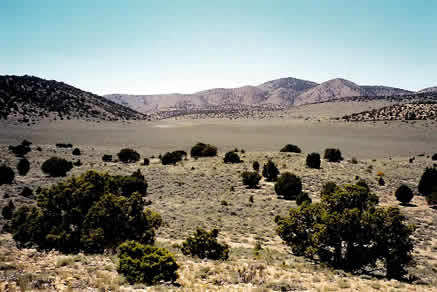Alternatives Examined in the DEIS
The Draft Environmental Impact Statement (DEIS) was released in April, 2003.
There are three alternatives:
1) Juniper Flat (original proposed action)
2) Cedar Flat (preferred, and environmentally superior
alternative)
3) No Action
The Inyo National Forest and the University of California (one of the members of the CARMA
consortium) have both determined the Cedar Flat site to be the environmentally superior
and preferred alternative.
The Bristlecone Chapter of CNPS strongly supports the decision to move the preferred
alternative away frm Juniper Flat.
Suggested Comments (in progress...)
1) MOST IMPORTANT: Support the Inyo
National Forest's decision to move the preferred alternative away from Juniper Flat!!
Don't let this proposal bounce back to Juniper Flat!!
2) ISSUE: The DEIS fails to consider the undisturbed
ecosystem at Juniper Flat as a resource, notwithstanding the Bristlecone Chapter's lengthy
written comments to that effect submitted in the scoping period. As a result the
DEIS contains only a piecemeal analysis of a few plant and animal species with neither an
adequate characterizion of the ecosystem itself nor analysis of potential project impacts
to the ecosystem, nor discussion of mitigation of system impacts.
SUGGESTED COMMENT: If there is to be any further consideration of the Juniper
Flat alternative, the comments of the Bristlecone Chapter of CNPS submitted in the scoping
period must be fully addressed. The intact ecosystem should be recognized as a resource of
value for conservation of native biodiversity, for study of ecological process, and for
use as a reference site for identification (by comparison) of anthropogenic impacts
elsewhere. Because of its high current value the ecosystem itself should be
given a thorough characterization including identification of species present in all life
forms (the DEIS ignores insects and soil biota entirely) and analyses of interactions
among species. Sufficient data should be gathered to asses the level of background
variation over time in species abundance and important ecosystem processes in order that
project impacts might be identified.
3) ISSUE: The DEIS asserts (pg. 2-20) that
Juniper Flat would be "restored to pre-construction conditions" after the 25
year lifespan of the proposed project. Quite apart from the self-serving nature of
this unsupportable assertion, there is no assurance proponents will have adequate funding
in 25 years to carry out the required restoration.
SUGGESTED COMMENT: A reclamation bond should be posted of sufficient
size to cover the anticipated costs (25 years from now) of thorough site restoration.
4) ISSUE: The DEIS assumes highly problematic mitigation methods
for invasive species (weeds) will be completely successful.
SUGGESTED COMMENT: Mitigation measure 4.5-1d (pg. 4.5-6) is
cited as grounds for asserting that impact 4.5-5 (Potential Introduction or Spread of
Weeds and Pests during construction) will be reduced to less than significant for both the
Cedar and Juniper Flat alternatives. Mitigation measure 4.5-1d lists several
specific actions which will be taken to try to minimize establishment and spread of weed
species during construction but provides no specifics about how weeds, once established
will be removed. It states only that "acceptable methods of removal" will be
employed.
Acceptable to whom? What does this mean? Are the "acceptable methods" also
effective? Given the
probablity of establishment in spite of the mitigation measure (attested to in Noxious
Weed Risk Assessment in Appendix D) as well as the fact that the weed species in question
are already out of control throughout the Great Basin and Mojave Desert, it is not
unreasonable to expect mitigation measure 4.5-1d to provide specifics on how weeds, once
introduced, will be extirpated.
The mitigation measure should also include a quantitative definition of
"success." Without such a definition mitigation goals will be
unenforcable. The EIS should also cite other projects of comparable spatial and
temporal scales in similar environments which applied this mitigation measure and met
quantitative standards of success. Without these additions, the use of mitigation measure
4.5-1d as grounds for asserting impact 4.5-5 will be mitigated to less than significance
is little more than wishful thinking.
5) ISSUE: The DEIS uses inappropriate criteria to
assess significance of impacts at Juniper Flat with regard to degradation of landscape
quality (impact 4.8-9, pg. 4.8-6) and loss of wilderness recreational opportunities
(impact 4.7-3, pg. 4.7-3). Specifically, the DEIS concludes that both impacts would
be less than significant simply because the Juniper Flat area currently is not heavily
visited.
SUGGESTED COMMENT: Significance of impacts should be measured with
regard to the impacted resource -- not the estimated frequency of current visitation.
According to the criterion used in the DEIS it would be virtually impossible to have
significant impacts anywhere in remote areas simply because one of the characteristic
features of remote areas is that they are infrequently visited because they are hard to
get to. The DEIS criterion amounts to "out of sight out of mind." The
old question "If a tree falls in the woods but no one is there to hear it, does it
make a sound?" might be paraphrased "If an observatory is built in a de facto
wilderness but only a few people see it, does it significantly impact the landscape?"
According to the DEIS, the answer is "no!"
6) More on the way!
Comments on the DEIS must be received on or before June 23,
2003 in order to be addressed in the Final Environmental Impact
Statement. Send comments before June 1 to:
Mr. Jeff Bailey
Supervisor
Inyo National Forest
873 N. Main Street
Bishop, CA 93514.
After June 1, send comments to:
Mr. Jeff Bailey
Supervisor
Inyo National Forest
351 Pacu Lane, Suite 200
Bishop, CA 93514
For more information about the project proposal, the EIS/EIR process, please call Chaz
O’Brien at 760/ 873-2490, or Nancy Upham, Public Affairs Officer, at 760/ 873-2427.
Visit the area yourself. See the map and instructions
below.
|


